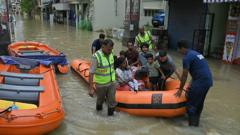The southern Indian city of Bengaluru, renowned for its thriving tech industry, is currently under severe duress following heavy rainfall that has inundated vast areas. The showers began on Sunday, and in just one day, parts of the city recorded over 100mm (around 4 inches) of rain—a phenomenon deemed "rare" by local weather officials. Tragically, three lives have been lost in rain-related incidents, including a 12-year-old boy, as the city braces for further rainfall due to cyclonic activity in the Andaman Sea.
With major technology firms in the city advising employees to work from home amid the chaos of flooded roads, the impact of the rainfall is being acutely felt. Among the casualties was a tragic incident in which the compound wall of the software company i-Zed collapsed, resulting in the death of a 35-year-old female employee.
Bengaluru has transformed into a scene of widespread water-logging, traffic chaos, and property damage. Videos from the ground show residents struggling through knee-deep water, while many vehicles remain marooned in submerged streets. With homes also affected by the inundation, local authorities are actively addressing the crisis by pinpointing 210 flood-prone areas that require immediate attention.
Despite officials assuring the public that there is no need for alarm, the situation has drawn sharp criticism from opposition parties regarding the state government’s management of infrastructure. The Bharatiya Janata Party (BJP), now in opposition in Karnataka, has voiced accusations of negligence, demanding an allocation of 10 billion rupees (approximately $117 million) for relief efforts.
Defending the government's position, Deputy Chief Minister DK Shivakumar acknowledged that the logistical issues are longstanding and have been neglected for years across multiple administrations. The recurring floods highlight deep-seated challenges linked to rapid urbanization, such as unchecked construction over vital wetlands and lakes.
As the residents of Bengaluru navigate the aftermath of this disaster, the city’s struggle with extreme weather and urban planning raises profound questions about the sustainability of its growth in the face of climate change.



















